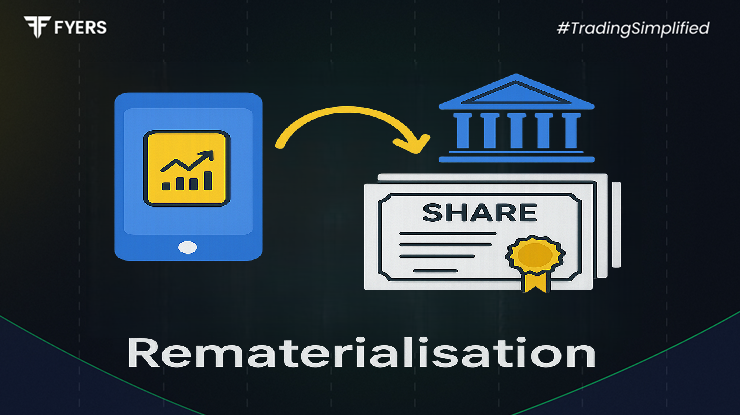

 23 Sep, 2025
23 Sep, 2025
 4 mins read
4 mins read

In the modern stock market, most investors hold securities in electronic form through a demat account. However, there are still situations where investors may prefer to switch back to traditional paper-based shareholding. This process is known as rematerialisation, often described as the conversion of electronic holdings into physical certificates.
Though not as common as dematerialisation, this option continues to exist under Indian market regulations. In this guide, we will explain what rematerialisation means, how it works, its advantages and drawbacks, and when investors may consider using it.
Rematerialisation of shares refers to the process of converting securities that are held electronically in a demat account back into physical share certificates. In simple words, it is the reconversion of securities into tangible paper form.
For example, if you currently own 100 shares of a company in your demat account but decide to switch them into physical stock certificates, you would initiate a rematerialisation request through your Depository Participant (DP). After processing, the company issues paper certificates showing your ownership.
To understand rematerialisation better, it’s useful to compare it with dematerialisation:
Dematerialisation – The process of converting paper-based certificates into electronic holdings stored in a demat account.
Rematerialisation – The opposite process, where securities held in demat are converted back into physical share certificates.
Both processes are regulated under the Depositories Act and supervised by NSDL (National Securities Depository Limited) and CDSL (Central Depository Services Limited).
In short, dematerialisation helps make trading seamless and faster, while rematerialisation provides investors with tangible proof of ownership in the form of printed certificates.
The steps to revert electronic holdings back into physical form are as follows:
Submit a Request – The investor fills out a Rematerialisation Request Form (RRF) and submits it to their Depository Participant (DP).
DP Verification – The DP verifies the details and blocks the securities in the demat account.
Forward to Depository – The request is forwarded to NSDL or CDSL, depending on where the demat account is maintained.
Registrar Notification – The depository then informs the company’s Registrar and Transfer Agent (RTA).
Issuance of Certificates – The company issues fresh paper-based share certificates in the investor’s name.
Completion – The securities are no longer held in demat but instead exist as physical stock certificates.
Timeframe – The process usually takes 30 days, but it may vary depending on the company’s registrar and the accuracy of documents submitted.
In today’s digital-first world, one might wonder why investors still request reconversion of demat holdings. Common reasons include:
Avoiding Demat Maintenance Costs – Every demat account requires annual maintenance charges (AMC). Some investors with low trading activity prefer to avoid this cost.
Limited Trading Activity – Investors who don’t trade frequently may feel paper certificates are sufficient for long-term holding.
Tangible Proof of Ownership – Some prefer physical certificates for record-keeping or legal purposes.
Compliance Reasons – Certain regulatory or legal requirements may make physical certificates necessary.
Sentimental Value – Long-term investors may prefer holding original certificates as proof of legacy holdings.
Cost Saving – No annual demat account maintenance fees.
Physical Evidence – Investors receive paper certificates that act as visible proof of ownership.
Simplicity for Passive Investors – Suitable for those who rarely buy or sell securities.
Risk of Loss/Damage – Paper certificates may get misplaced, stolen, or damaged by accidents.
Cumbersome Process – Transferring physical certificates requires more paperwork and time.
Lower Liquidity – Selling shares held in physical form is slower compared to trading via demat.
Extra Charges – Some companies may levy a rematerialisation fee.
Suppose Mr. Sharma owns 1,000 shares of XYZ Ltd. in his demat account. He rarely trades and wants to avoid annual demat maintenance fees. He submits a Rematerialisation Request Form to his DP. After verification, NSDL forwards the request to XYZ Ltd.’s registrar.
Within 30 days, Mr. Sharma receives fresh paper share certificates for his 1,000 shares. His demat account balance is reduced, and ownership is now represented by physical certificates.
|
Advantages |
Disadvantages |
|---|---|
|
Saves annual demat maintenance charges |
Risk of losing or damaging certificates |
|
Provides tangible proof of ownership |
Paper-based transfer is slow |
|
May be preferred for legal or compliance needs |
Lower liquidity in trading |
If you are a long-term investor with little trading activity.
If you want to avoid recurring AMC charges on demat accounts.
If you prefer tangible ownership evidence.
If regulatory or legal reasons require physical certificates.
However, for most active traders and modern investors, dematerialisation remains the superior choice due to its speed, convenience, and security.
Rematerialisation of securities, also called reconversion of demat holdings into paper form, remains an available option for investors in India. While it provides physical proof of ownership and saves demat charges, it also comes with risks such as loss or damage of certificates and slower transaction processing.
For investors who trade regularly, keeping securities in demat form is more efficient. However, for those who prefer tangible proof and minimal costs, reverting to physical shareholding may still hold value.
It is the process of converting shares from electronic form back into physical certificates.
It usually takes around 30 days, though timelines may vary.
Dematerialisation converts physical certificates into electronic form, while rematerialisation is the reverse process.
To avoid demat account charges, keep tangible proof of ownership, or meet specific legal/compliance requirements.
Calculate your Net P&L after deducting all the charges like Tax, Brokerage, etc.
Find your required margin.
Calculate the average price you paid for a stock and determine your total cost.
Estimate your investment growth. Calculate potential returns on one-time investments.
Forecast your investment returns. Understand potential growth with regular contributions.